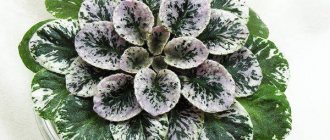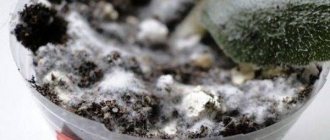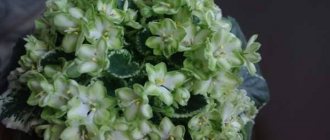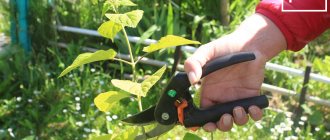Violets are perhaps one of the most popular and numerous types of indoor plants. Since the “domestication” of these mini beauties, breeders have already bred about 32,000 of the most interesting varieties. Conventionally, they can be divided into groups that differ in colors, types and shapes of rosettes. How are mini violets different from others?
The main difference is the size of the outlet:
standard up to 60 cm;
· semi mini up to 20 cm;
· mini no more than 15 cm;
· micro mini up to 6 cm.
The size of leaves, flowers, their color and shape depend on the variety. The “mini” group currently has 3,000 varieties. The flowering period of these miniature beauties is not tied to the time of year, like many other indoor plants. With proper care, mini violets bloom for 5 to 7 months. In particularly favorable conditions, flowers can completely cover a bowl of small colorful leaves, and gardeners are simply delighted with this!
What mini violets look like
The botanical features of this subshrub are the same as those of all members of the family. Leaves are alternate or in a basal rosette. The surface is fleecy. Flowering is characterized by a rich color palette. Petals can be plain or variegated. There are cup-shaped buds, double buds and more. Each has 5 petals. Sepals are often present. Belongs to self-pollinating species. In place of the buds, a seed box is formed.
Violet mini Le blue buttercup
All varieties are divided into three groups:
- micromini – flower diameter does not exceed 6 mm;
- mini – flowers reach 1.5 cm;
- semi-mini – diameter up to 2 cm.
The symmetrical, fan-shaped cap of greenery with inflorescences, which can be observed for 5-7 months a year if the plants are properly cared for, is whimsical. This flower will look great next to succulents and mini-trees, indoor herbaceous flowers and vines.
Description of common varieties
How to feed violets for abundant flowering at home
The semi-mini violet Crimson Magic has burgundy-colored petals curled along the edge. Severity and tenderness are harmoniously combined in them.
The flower will give you a romantic mood. It will create a holiday by settling on the windowsill.
The white edging on the leaves of the mini violet variety Shirl's Red Sky will convince even a skeptic that this is the queen of indoor flowers. It is especially charming when the pink and lilac buds appear. But even when there are no inflorescences, it is not the season for bright colors, the bush looks original and attracts attention.
Each variety has its own special charm
Supporters of extravagance and non-standard solutions will like the miniature Saintpaulia Le - blue buttercup. It is unlike any other variety. The soft green buds gradually become bluish and lilac.
The semi-mini violet Le Scales also looks no less original. The blue flowers are gorgeous. The foliage is heterogeneously colored and attracts attention. Coral and platinum inclusions create a pleasant contrast with the dark green background.
The mini violet called N-Thumbelina has pink-orange flowers. Their shade is close to neon. The edges are outlined with a thin crimson rim. A special feature of the Irish Flirt variety is the waviness of the petals. Mac's Flamboyant Flame has them, on the contrary, pointed. In the winter rose they are located in such a way that this mini violet can really be confused with a rose.
These are just a few popular varieties. There are many of them. Breeders are enthusiastically conducting more and more daring experiments in order to surprise and amaze flower growers and violet lovers.
Briefly about the history of appearance
Today, violets are found in Siberia, the Caucasus, and Crimea. They grow in Europe, Asia, North and South America. You can meet them in the forest and in the mountains. The mini violet was bred by breeders in the 50s of the 20th century; it retains connections with wild species, but at the same time is not similar to them.
Requirements
There are certain requirements when planting violets.
To the potty
- If he talks about the material of the pot, then it can be stone, wood, ceramic or plastic.
- The main requirement of a flowerpot is its shape. It should not be narrow and deep.
- At the first stage of life, the pot chosen is small. This could be a 100 gram plastic cup. To prevent water from collecting at the bottom, use a soldering iron to make a hole.
- As the plant grows, the pot also doubles in size from the previous one.
- The width of the flowerpot should be equal to the circumference of the crown. The flower will bloom only when it envelops the entire clod of earth.
To the ground
- The soil for violets is loose and well-drained.
- Drainage in the form of agroperlite, coal, expanded clay, and pebbles is placed at the bottom of the pot. To allow the roots to breathe, fill the drainage to a quarter of the container.
- You can add soil substrate, perlite, and vermiculite to the soil for violets. These substances will help the soil not to clump, but to be loose.
- Acidity is within the range of 5.5-6.5 pH.
- After watering, it is good to use mulching, for example, with vermiculite. It will nourish the bush and at the same time retain moisture.
- Moderate dose of nitrogen.
- Favorable microflora.
- Absence of pests and their larvae.
The nutritional properties of soil purchased in stores must be improved by adding the following components:
- If turf soil is used, it will be saturated with nitrogen.
- Leaf humus. It can be taken under linden and birch trees. Only the top layer is removed first. The soil on which the grass grows will be of high quality.
- Dung humus. Its quality is determined by nettle. Its presence on the heap is a good sign; you can safely take the humus.
- Compost soil. It will be of high quality 3 years after it is filled. There are some components that are used to retain moisture, for example, high-moor peat. Sphagnum moss is involved in its formation. Since it is acidic, it should be diluted with dolomite flour.
- Needles. To collect coniferous soil, you need to remove a layer of needles from the ground, this will be the next one. It is only advisable to collect it after rain and store it in a plastic bag. Do not forget about slight acidity, so lime must be added to such soil.
- Sphagnum moss. It has an interesting property: it can absorb water ten times its weight and is bactericidal. Use it dry and fresh, just cut it into pieces. It also has acidity, so it goes with dolomite flour or lime.
- Vermiculite. Can be used in combination with peat. Retains moisture and reduces acidity.
Soil cultivators:
- Sand. Coarse river sand is good. In order to achieve this, you need to sift it through a sieve several times.
- Finely chopped straw.
- Green moss.
- Sawdust.
- Sphagnum moss.
- Pine bark, finely chopped.
- Fern roots.
Recommended mixtures:
- Sphagnum moss, humus or compost, river sand, leaf soil 1:1:1:1.
- "Saintpaulia", sand, compost soil or humus 1:1:1. For half a bucket of the mixture, 100 g of charcoal.
- Charcoal, vermiculite, compost and leaf soil 0.5:2:2:2.
A prerequisite for preparing the mixture is its sterilization. Various methods can be used for this. For example, spread the soil onto a tray and roast for 2 hours in the oven. Or take a colander, cover it with a cotton cloth, pour the mixture on top and place in a water bath. The soil will be perfectly steamed and will be ready for use. You can use the mixture on the third day.
Features of caring for mini violets at home
Bokarneya: home care and popular types
The microclimate of the room in which purchased indoor flowers find themselves sometimes does not meet their requirements, so the plants wither. No matter what the owner does, the result is not comforting.
Important: having bought a mini violet, in the first few days of its stay in a new place, you need to adjust the lighting, air temperature, humidity level, follow the watering rules, and replace the soil if necessary.
It is advisable to prepare everything in advance. Miniature violets are plants with strong immunity. If the environment is not suitable for them, they will be able to actively grow for a while. Then they will begin to fade. The owner must care for the plant and pay close attention to its needs. Otherwise, unpleasant surprises cannot be avoided.
Temperature
The air temperature in the room in winter should be from +20 and above, and in summer, from +25 to +28. In this case, everything will be fine with mini Saintpaulias.
Lighting
The plant loves sunlight. Daylight hours should be 10-12 hours all year round. That is, it is advisable to use bio lamps.
Watering
Mini violets do not tolerate excess moisture in the soil. They react extremely negatively to too frequent watering, large amounts of water, or a pot without holes in the bottom. They should be watered twice a week, removing dried leaves and inflorescences, if any. It is advisable to pour water along the edges of the planting container, and not at the root.
Humidity
Air humidity is of great importance for violets. But creating the right conditions is easy. If there is excessive humidity, you should ventilate the room, and if there is insufficient humidity, place a container of water next to the flower. The flower itself will help determine that the air humidity is not suitable. In the first case, the leaves begin to wither faster and become smaller over time. In the second, on the contrary, they grow too big. Disproportion makes a negative impression; the bush is sloppy and lacks symmetry.
Priming
Sand is useful for creating a drainage layer at the bottom of a flower pot. Chernozem should be used as soil. It should be loose: the root system of the flower will not rot, and watering and fertilizing will give a more pronounced effect. To make the soil “airy” and light, sand or sawdust or tree bark are most often used.
Need light, nutritious soil
This is a good option, but experts recommend choosing more specific types of baking powder:
- perlite;
- vermiculite;
- sphagnum moss.
They will enrich the soil with mini minerals important for the growth and development of Saintpaulia. The risk of infection by wood beetles and other pests is eliminated.
Feeding
Classic mineral mixtures for indoor plants are universal and are also suitable for this flower. They help you save money while maintaining your home garden in perfect condition.
Which pot should you choose?
First of all, you should rely on the general rule for choosing a flowerpot for violets: the diameter should be ⅓ of the size of the rosette. And the second, no less important rule: plants feel best in plastic containers. Thus, a pot with a diameter of 5-6 cm will suit a mini violet.
· Is it possible to take a larger pot? It is possible, but in this case there is a risk of root rotting from overwatering. Or the plant will grow larger than its usual size, one might even say, it will turn into a semi-mini.
· Could the pot be smaller? Maybe, but you will have to replant the violet at least once every 6 months and fertilize it regularly.
If you follow simple rules for choosing a flowerpot and the frequency of replanting, you do not need to apply additional fertilizers.
Mini violets bloom faster than their larger counterparts. They are also more resistant to disease. Following simple rules will ensure a long life for these charming little ones and they will certainly thank their owner with long-lasting and delightful flowering.
When and how does it bloom
How to water violets - rules and features of watering
The flowering period does not depend on the time of year. Saintpaulia mini is a completely domesticated flower. The duration of flowering is determined by the variety. In most cases this is 4-5 months. If the ovaries do not form, you should be more careful about care. Perhaps there is not enough light or nutrients.
Important : During the flowering period, Saintpaulia should be watered more often, with a large amount of liquid. The need for nutrients and moisture increases.
Preparing the plant
- To avoid damaging the root, you need to moisten the soil before replanting.
- Then carefully pull out the socket along with the lump. It should not be too wet and stick to your hands, nor too dry.
- Prepare a pot that is twice the size of the previous one.
- If it is old, it should be washed to remove salt deposits.
- It is better to use a plastic flowerpot. Ceramics and clay help the soil dry out quickly.
- The soil is prepared nutritiously with the addition of peat and sand.
- The bottom is filled with drainage.
- Then the soil mixture is poured.
- The lower leaves slightly touch the ground when planted.
- To ensure humidity, the pot is covered with a cap.
Transplanting mini-violets after purchase
It is recommended to replant some flowers every few years. In the case of mini violets, home care involves annual replanting. Thanks to this, it will be protected from salts and mineralization accumulating in the soil. For the first time, it is advisable to perform the procedure immediately after purchase in order to awaken defensive reactions and trigger the adaptation mechanism.
It is recommended to replant the flower immediately after purchase.
This is also an excellent opportunity to replace the planting container with a decorative one. If you place the violet close to the edges of the pot when planting, a green island will appear on the windowsill. When planted deep, it will evoke associations with an exquisite bouquet.
The dimensions of the new flower pot should be the same as the container in which the violet was sold. The exception is those cases when it is discovered that the root system is more developed and no soil supply is provided. In such a situation, you need to use a larger pot.
To extend the flowering period
Flower growers sometimes use a little trick: they place the blooming Saintpaulia in a room with a temperature slightly below normal. This will prolong flowering, however, care should be taken as you can freeze the viola. If a young, not fully formed violet finds itself in such conditions, its growth and maturation will slow down significantly. By maintaining a simple balance between proper watering and temperature conditions, the flowering and growth of these beautiful plants occurs more luxuriantly and longer.
Adult plants periodically need cosmetic care. If necessary, remove yellowing lower leaves. They spoil the appearance of the violet. However, after some time a trunk may form. To get rid of it, the next time you replant, you just need to plant the mini violet a little deeper. It will quite quickly sprout new roots in place of the previously removed leaves.
Violet requires replanting on average once every 6–9 months. The soil for miniature beauties should be loose and moderately acidic. It is better to purchase prepared substrate in specialized stores. You can also prepare the soil yourself.
Possible problems in growing mini violets at home
Not only violation of the rules of care can lead to problems. If the cuttings rot, it is necessary to cut off the damaged leaves and reduce the frequency of watering. But when brown spots appear on the leaf blades or when young shoots wither, you need to save the flower from mites.
External signs of problems
A well-groomed violet looks elegant. The foliage is symmetrical. Flowering is stable and colorful. Ungroomed – has a less attractive appearance. If attacked by a fungus or mite, her future is in question. There may be two or three leaves left in the end, then they too will fall off.
Diseases
Powdery mildew can cause damage to the flower. The foliage becomes covered with a white coating and becomes thinner. This is a sure sign of a growing fungal population. After some time, dried areas become noticeable. It is advisable not to delay treatment until later; cut off damaged leaves immediately.
One of the signs of flower disease is dark-colored spots on the leaves.
Only in rare cases is this measure sufficient and the violet recovers on its own. Most often, lesions appear in other areas within a day or two. Purchasing a fungicidal drug and treating the flower and soil with a specialized product will change the situation.
Important : every violet leaf is valuable. Reproduction occurs by seed or by rooting leaves.
Pests
Ticks often live on indoor plants, violets in particular. The structural features of the mini violet bush and leaf plate are attractive to them. Signs of their presence are:
- darkened, red or brown spots on the leaves outside and inside;
- thin cobweb;
- deformation of leaves - tubercles, compactions against the background of thinned sectors, unnatural surface roughness.
A unique indoor flower, the miniature violet is indispensable when creating an atmosphere of comfort and romance in a room. Her neat bush reminds of restraint and rules. The soft edge of the foliage refracts the light, creating a barely noticeable glow. The bright colors of the petals improve your mood.
Reproduction
Among florists, the most common way to replenish your collection of semi-mini and miniature Saintpaulias is the method of propagating indoor flowers using leaf cuttings.
Its essence is extremely simple and consists of the following: a leaf of an adult, preferably healthy Saintpaulia is taken along with a cutting and placed in warm, settled water until the measles system is formed and subsequently transplanted onto the ground, and at the very end the plants are planted.











